This week on Legion’s Landing, Kristen shares a casual Renata, Called to the Hunt EDH, and some of the ethos behind building such a deck.
With the World Championships taking up much of everyone’s attention this weekend, I didn’t have much time to delve into one of my more complex current projects. Instead, let’s take a look at a deck that I threw together this weekend to serve a purpose.
Renata, Called to the Hunt
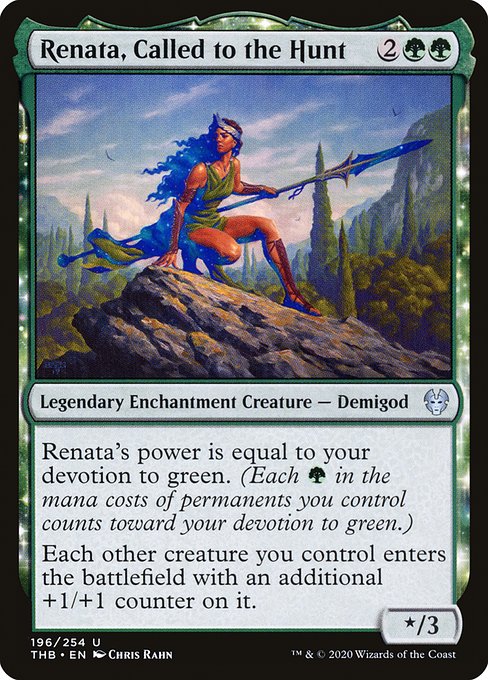
So, Renata. When most people saw this card, I’d imagine their first thought—Commander wise, at least—was that she’d fit great into either a Simic or Abzan +1/+1 counters theme. Either that, or in a Nylea deck. Those are both great places to put her, but I can’t imagine many are building her in the starring role. Checking EDHRec, I’d be right—only 22 decks! So, why did I settle on her?
Well, to set the scene—one of my friends in my local playgroup has had his heart set on building a tribal spiders deck for quite some time. Ever since we got stomped by an Ishkanah, Grafwidow combo deck (think Nim Deathmantle & Ashnod’s Altar), he’s been a little reluctant to follow through. With some of the new spiders in Theros Beyond Death, his interest was renewed, and so we sat down to chat about the fact we should all throw together a more chill deck. This appealed to me, as some of what I’d consider my more casual decks, like Lyra Dawnbringer and Sylvia & Khorvath have gradually crept up the powerscale due to upgrades, additions and new card printings. I guess I’ve also gotten better at piloting them, too.
I now had motivation to add another more “chilled out” deck to my repertoire, not least so that I had something more appropriate to play against newer players at the shop. I set myself a few guidelines, too:
- First, my deck had to be themed. I settled on the idea of “The Hunt.” This deck would involve both predators and prey, hunters and hunted.
- Next, I had to, where possible, avoid the use of “best in slot” cards. Think avoiding Oracle of Mul Daya and Craterhoof Behemoth.
- Instead, I would (where possible) choose a thematic card. So think Omen of the Hunt over Kodama’s Reach.
- I would have to use solely the cards in my collection, and not go and buy any more.
- Mana doublers were off the table. No Nissa, Who Shakes the World, and no Zendikar Resurgent. I find these cards can really spiral out of control, and I didn’t want to hit two-spells-a-turn territory quicker than my friends who were also in on the challenge.
- I would intentionally avoid any easy-to-break combos, but still allow myself strong synergy cards. Playing Hardened Scales would hardly be game-breaking if the cards I’m augmenting are medium to start with.
With that in mind, I put together a deck. It took me roughly 45 minutes to build, which is actually quite quick, given I usually pore over decks for days at a time fine tuning. I also only had 78 spells selected for my first draft, which is honestly really low. I usually end up looking over 90-110, easy.
The Deck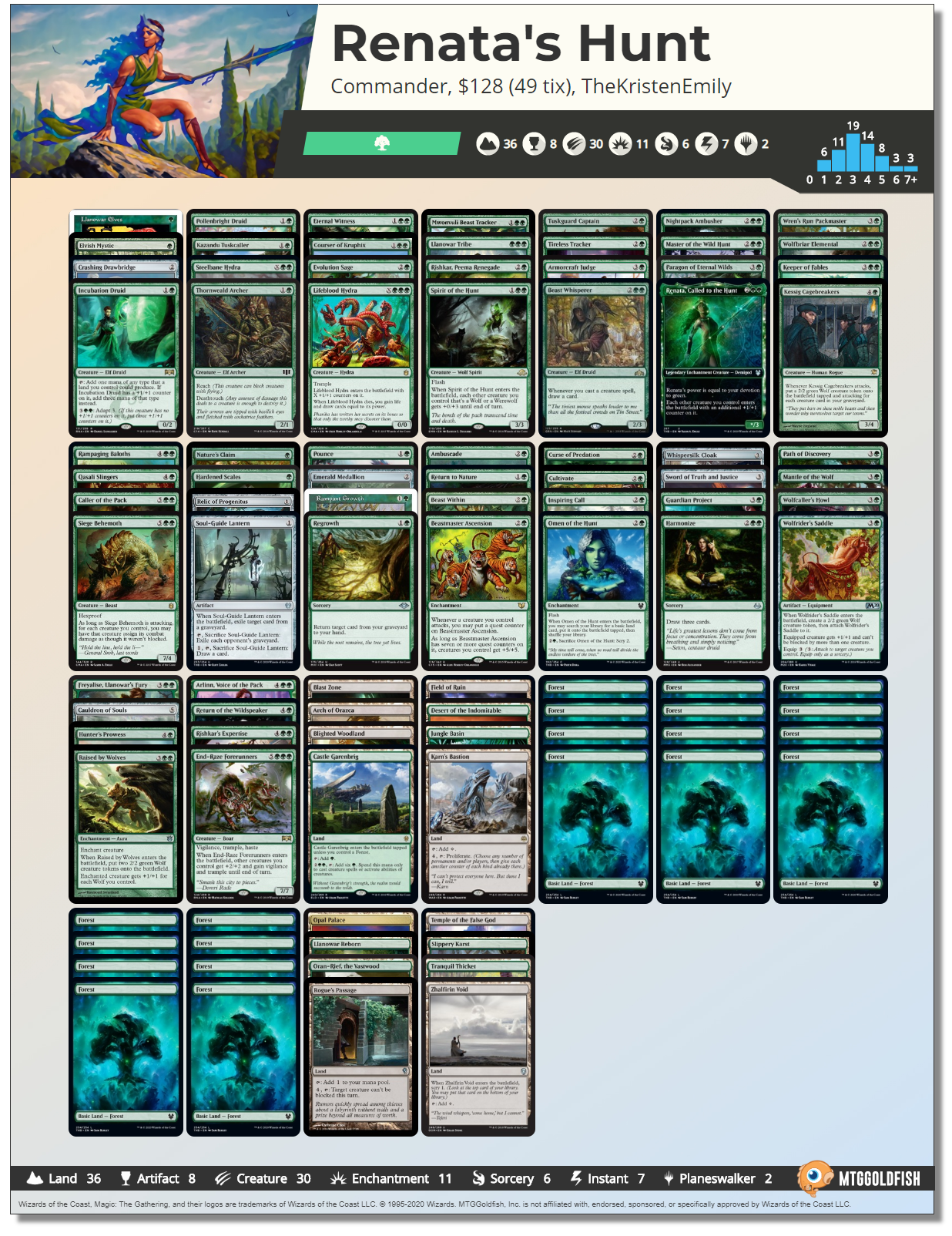
You can take a look at the full list here. We’re running a healthy 30 creatures, and a bunch of ways to flood the board even wider with tokens. The general strategy is a classic Green beatdown—go tall and relatively wide before playing some kind of finisher to enhance the lethality of our board. In the building process, I hit upon having two main tribes in the deck: wolves and elves. This makes cards like Wren’s Run Packmaster very playable, but cards like Vanquisher’s Banner not so playable. Green is never short on consistency with its bevy of ramp and draw options, and thankfully, there are a number we can run which are on theme.
Though some cards fall outside the main theme, their inclusion is pretty justified with some basic logic. Tireless Tracker could quite easily be a part of the Hunt. Others, like Incubation Druid, are a little harder to explain away; but given that the power level on the card isn’t through the roof, and that it synergizes incredibly well with our Commander (and is an Elf Druid to boot), I think I can still sleep at night. Let’s move on to the main themes.
Voice of the Pack
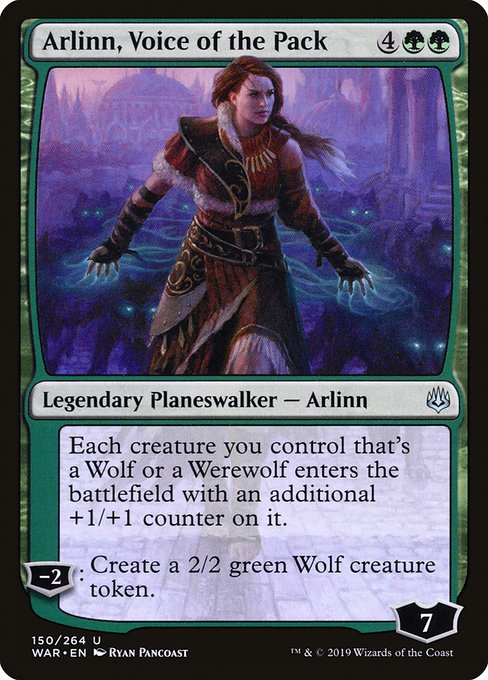
Arlinn, Voice of the Pack brings a whole host of wolf-kind with her to the Hunt. She’s a great signpost card for one aspect of what the deck is trying to do: put +1/+1 counters on wolves, and make wolves. Master of the Wild Hunt, Wolfcaller’s Howl, and Wren’s Run Packmaster join Arlinn as our main repeatable token production engine, with Wolfbriar Elemental offering a berth of wolves should we have the mana to put into it. Nightpack Ambusher is a fine card to ambush with, and can also give us some tokens, as can Kessig Cagebreakers following a wrath.
Spirit of the Hunt is a thematic home run that doubles as protection, and both Mantle of the Wolf and Raised by Wolves can augment our Commander to strengthen her low toughness while also conferring a power boost and more wolf tokens.
We’re also in the market to make tokens with Kazandu Tuskcaller, a card that is very often stripped straight out of pre-cons to be replaced by better cards. Sure, it’s a little slow, but with our ways to augment the tokens, and proliferation, it becomes a lot more playable.
Counting Dice
Generally speaking, having decks that deal in both tokens and +1/+1 counters is a real bummer to keep track of, so I’ll apologize for that in advance. We start things off with a classic Hardened Scales. It’s hard to say no to such a synergistic card in this deck. Likewise, Path of Discovery can offer us a tonne of consistency. Curse of Predation keeps the counters coming, while Tuskguard Captain offers us sorely needed trample for our efforts.
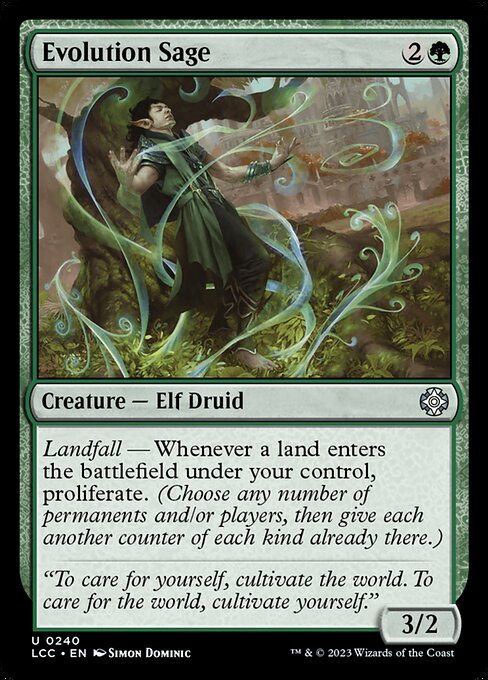
We can proliferate those counters with Evolution Sage, Karn’s Bastion, or Oran-rief, the Vastwood (kinda). Pollebright Druid can also proliferate, and is just one of the many elves we can champion with Wren’s Run Packmaster. Closing things out, we have Llanowar Reborn in our manabase, and Sword of Truth and Justice, an amazing equipment in this kind of deck, not least because our Commander will very likely run into the best white removal spells.
Embarking on the Hunt
There are a few ancillary cards worth mentioning before we look at the supporting structures of the deck that are worth bringing up. First, Crashing Drawbridge can do a lot to enable our stompy strategy by letting us get value from our creatures before crossing our fingers and hoping a wrath doesn’t go off. Mwonvuli Beast Tracker is another flavor-win that helps us dig out a win condition, and Tireless Tracker is a value engine that never truly crosses into obnoxiousness given our lack of fetchlands.
Given we’re running a menagerie of creature types, I’ve decided to opt for Paragon of Eternal Wilds. It gives +1/+1 to basically our entire team, and can vitally grant Trample should we have a creature big enough that will end up being chump blocked.
Wolfrider’s Saddle is perhaps the most meme-level card in the deck. It’s decidedly weaker than most things we could run in the slot, but don’t sniff at the ability to both create a wolf token and also give our Commander a way to not die when swinging. Being able to only be blocked by one creature means if we’ve had any chance to grow her beyond three toughness, she’ll at the least be trading with something important.
That three toughness can quickly become an issue, though, so for that reason we’re running Opal Palace and Rogue’s Passage in the manabase, and Whispersilk Cloak as a way to help her get in. Renata is a surprisingly quick clock when her power grows with devotion! It can probably be justified from a flavor point, too—a Demigod is easily capable of such trickery.
Removing Threats
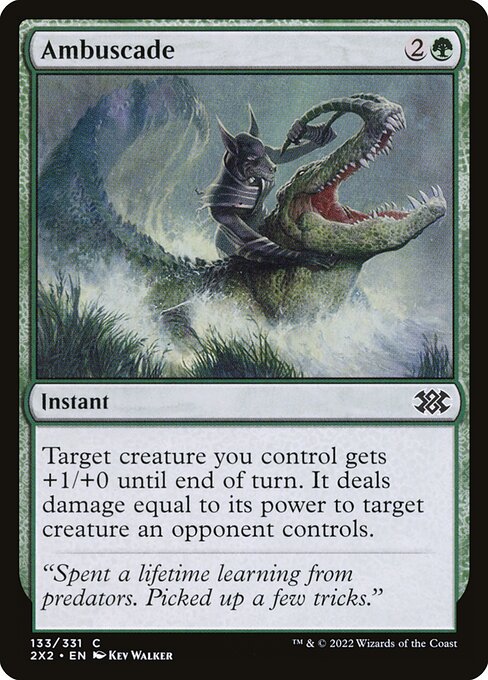
Every deck needs removal, but I’ve tried to limit the amount of interaction, and also opted for more interesting choices where possible. Qasali Slingers beats out Reclamation Sage—it’s much more Hunt-themed, and can trigger again with our card draw creature Keeper of Fables if we’re lucky. Joining mainstays Beast Within, Nature’s Claim, and Return to Nature we have Ambuscade and Pounce (suitably hunt themed removal), Steelbane Hydra, and Freyalise, Llanowar’s Fury. I wanted to keep the number of elves in the deck high so Wren’s Run Packmaster was never a dead card, and putting token generation in with draw and removal seemed a good bet.
We haven’t forgotten graveyard interaction, either, and run both Soul-Guide Lantern and Relic of Progenitus.
Ending the Game
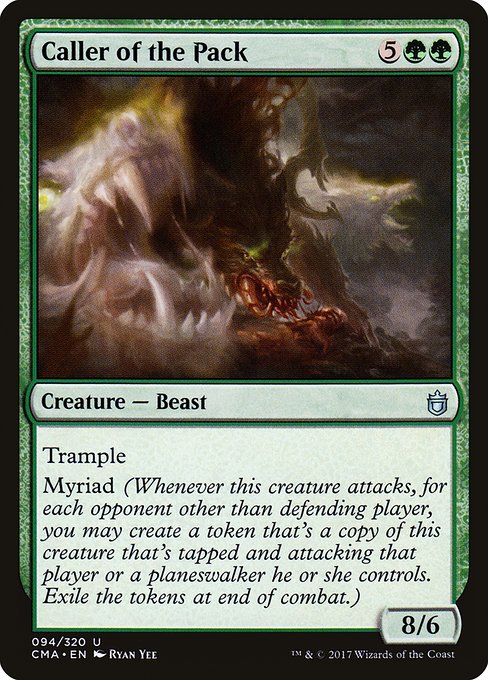
Given the relatively lower power level of the deck, a card like Rampaging Baloths is definitely a finisher. Again, due to not having an abundance of ways to loop lands, it’s not as great as it could be. Caller of the Pack is a nice thematic beatstick, while Beastmaster Ascension, Siege Behemoth and End-Raze Forerunners all do their best Craterhoof Behemoth impressions. It’s important even in a casual build to have some way to end the game, as sitting behind an army of very medium tokens isn’t really going to get us anywhere.
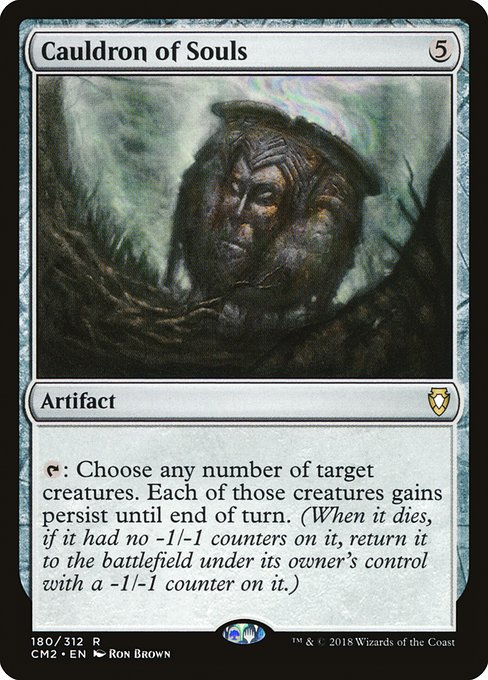
To keep up the momentum, we are taking advantage of the +1/+1 counters Renata provides with Cauldron of Souls. It gets around boardwipes very well, and if left unchallenged, gives us a steady way to bounce back with little effort. Likewise, Inspiring Call fills our hand while preserving our board, and Return of the Wildspeaker can be both an overrun style effect and a card draw spell—whatever suits us best.
The Core Structure
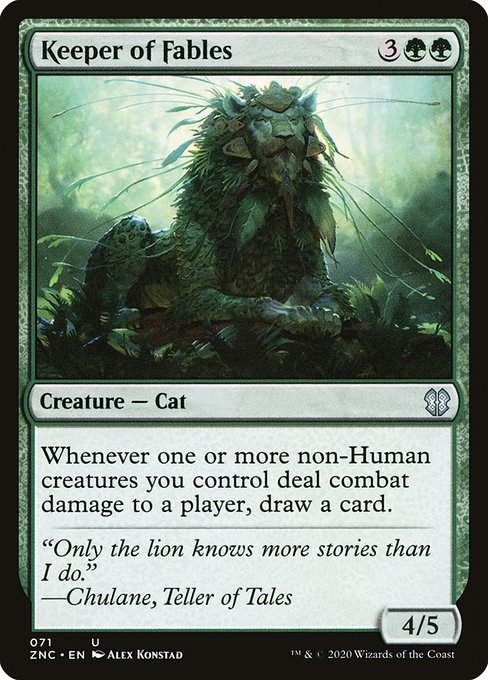
Our main strategy accounted for, we do need a way to pull it off. Green doesn’t lack in card draw, but for every Rishkar’s Expertise, we’re running a Hunter’s Prowess or a Keeper of Fables. Beast Whisperer is right on theme, and Armorcraft Judge while thematically a stretch, is a home run mechanically. Lifeblood Hydra is a meaty threat that gives back when it dies, and for that, we’ll be eternally grateful.
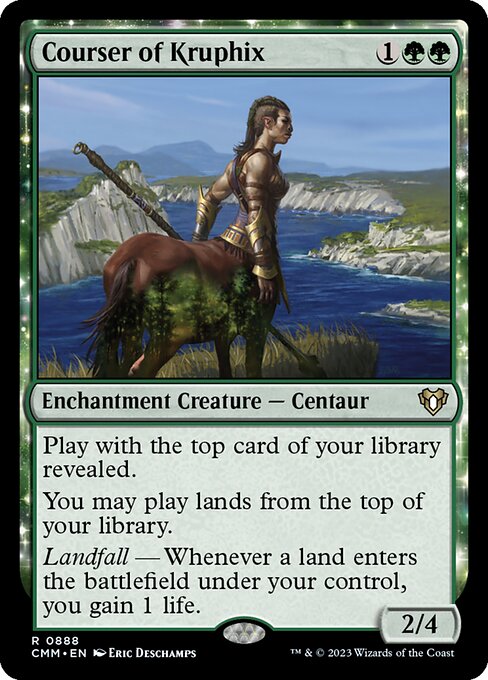
Ramp wise, we’re running Courser of Kruphix over Oracle of Mul Daya. The Oracle is just that much better, but Courser turns things down a notch while giving us extra points of devotion. Omen of the Hunt beats out Kodama’s Reach, but we can’t really pass up Cultivate, as it’s such a staple for Green decks. Llanowar Tribe offers a chunk of devotion and a chunk of mana, while Incubation Druid, Elvish Mystic, and Llanowar Elves round out our mana dorks. Like Incubation Druid, Rishkar, Peema Renegade synergises with our mechanical identity very well indeed.
Keeping Things Casual
There are countless ways this deck could be improved upon. We currently run no copies of Nylea (or Rhonas, for that matter), and aside from value cards like Parallel Lives and Doubling Season, we could really stretch out the manabase with utility lands. Something like Forgotten Ancient would slot in perfectly here, as would any number of green Planeswalkers. Fangren Firstborn is easily an option, and if we go that route, it’s really not far before we’re thinking about Infect. I’ve also missed out staples like Acidic Slime, because, well, it doesn’t really fit, does it?
We could really stretch that ramp package to enable larger colorless cards like Ugin, the Spirit Dragon or Eldrazi, and we could throw aside the Hunt theme entirely and really lean into the +1/+1 counters theme. There’s an abundance of ways to really break that synergy; if you’re going down that route, you could easily just play a Simic deck instead. One of my test games ended in my opponent regretting playing an Intruder Alarm—I had Kazandu Tuskcaller, Incubation Druid, and Llanowar Elves in play. It’s really that easy to go infinite, and that couldn’t be further from the goal with this deck!
As I’ve covered in previous articles, it really is a lot easier to build casually when you have some strong restrictions. It’s worth mentioning, though, that even with these restrictions, the deck is still perfectly capable of snowballing in short order. Green has earned its reputation as the best color, and building a casual Green deck is an easy way to prove it. Even when considering some of the third, fourth or later picks for cards to include in slots, Green’s options are still far better on average than those available in other colors.
How do you keep things casual? Have you started a casual challenge with your group? Let me know what you think on Twitter to continue the discussion.
Based in the UK, Kristen is a lover of both Limited and Commander, and can most often be found championing the Boros Legion when called upon to sit down and shuffle up.

